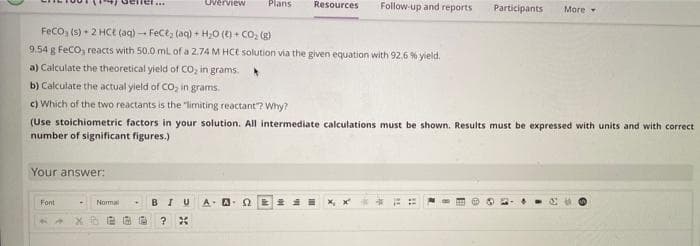Feco, is) • 2 HCE (aq) - FeCt; (aq) + H,0 () co, () 9.54 g Feco, reacts with 50.0 mL of a 2.74 M HCt solution via the given equation with 92.6 % yield. a) Calculate the theoretical yield of CO, in grams. b) Calculate the actual yield of CO, in grams. c) Which of the two reactants is the "limiting reactant? Why? (Use stoichiometric factors in your solution. All intermediate calculations must be shown. Results must be expressed with units and with correct number of significant figures.)
Feco, is) • 2 HCE (aq) - FeCt; (aq) + H,0 () co, () 9.54 g Feco, reacts with 50.0 mL of a 2.74 M HCt solution via the given equation with 92.6 % yield. a) Calculate the theoretical yield of CO, in grams. b) Calculate the actual yield of CO, in grams. c) Which of the two reactants is the "limiting reactant? Why? (Use stoichiometric factors in your solution. All intermediate calculations must be shown. Results must be expressed with units and with correct number of significant figures.)
Introductory Chemistry: A Foundation
9th Edition
ISBN:9781337399425
Author:Steven S. Zumdahl, Donald J. DeCoste
Publisher:Steven S. Zumdahl, Donald J. DeCoste
Chapter15: Solutions
Section: Chapter Questions
Problem 39QAP: 39. Standard solutions of calcium ion used to test for water hardness are prepared by dissolving...
Related questions
Question

Transcribed Image Text:Overview
Plans
Resources
Follow-up and reports
Participants
Моге
Feco, (s) + 2 HCe (aq) - Fect, (aq) + H20 (t) + CO, (g)
9.54 g FeCo, reacts with 50.0 ml of a 2.74 M HCE solution via the given equation with 92.6 % yield.
a) Calculate the theoretical yield of CO, in grams.
b) Calculate the actual yield of CO, in grams.
c) Which of the two reactants is the "limiting reactant"? Why?
(Use stoichiometric factors in your solution. All intermediate calculations must be shown. Results must be expressed with units and with correct
number of significant figures.)
Your answer:
Font
BI
A. A. 2
Normal
%3B
Expert Solution
This question has been solved!
Explore an expertly crafted, step-by-step solution for a thorough understanding of key concepts.
Step by step
Solved in 2 steps with 2 images

Knowledge Booster
Learn more about
Need a deep-dive on the concept behind this application? Look no further. Learn more about this topic, chemistry and related others by exploring similar questions and additional content below.Recommended textbooks for you

Introductory Chemistry: A Foundation
Chemistry
ISBN:
9781337399425
Author:
Steven S. Zumdahl, Donald J. DeCoste
Publisher:
Cengage Learning

Chemistry & Chemical Reactivity
Chemistry
ISBN:
9781337399074
Author:
John C. Kotz, Paul M. Treichel, John Townsend, David Treichel
Publisher:
Cengage Learning

Chemistry & Chemical Reactivity
Chemistry
ISBN:
9781133949640
Author:
John C. Kotz, Paul M. Treichel, John Townsend, David Treichel
Publisher:
Cengage Learning

Introductory Chemistry: A Foundation
Chemistry
ISBN:
9781337399425
Author:
Steven S. Zumdahl, Donald J. DeCoste
Publisher:
Cengage Learning

Chemistry & Chemical Reactivity
Chemistry
ISBN:
9781337399074
Author:
John C. Kotz, Paul M. Treichel, John Townsend, David Treichel
Publisher:
Cengage Learning

Chemistry & Chemical Reactivity
Chemistry
ISBN:
9781133949640
Author:
John C. Kotz, Paul M. Treichel, John Townsend, David Treichel
Publisher:
Cengage Learning

Chemistry for Engineering Students
Chemistry
ISBN:
9781337398909
Author:
Lawrence S. Brown, Tom Holme
Publisher:
Cengage Learning

Chemistry: Principles and Practice
Chemistry
ISBN:
9780534420123
Author:
Daniel L. Reger, Scott R. Goode, David W. Ball, Edward Mercer
Publisher:
Cengage Learning

Chemistry by OpenStax (2015-05-04)
Chemistry
ISBN:
9781938168390
Author:
Klaus Theopold, Richard H Langley, Paul Flowers, William R. Robinson, Mark Blaser
Publisher:
OpenStax